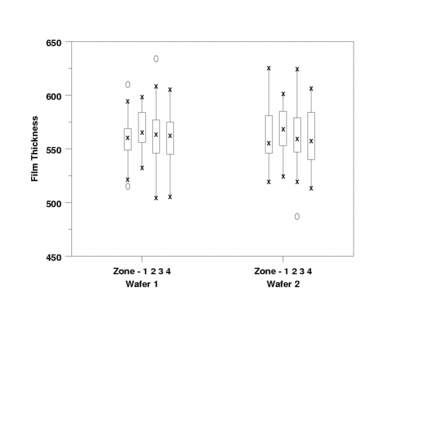

|
CODE CROSS TABULATEName:
with Y denoting a response variable and X denoting a group id variable. There may be times when you want to use one of these commands when there are multiple group id variables. For example, you may want to generate box plots, mean plots, or strip plots for the values withn each combination of group id's. It can also be used to simplify multiple SUBSET clauses. The CODE CROSS TABULATE command can be used to generate a single group id variable from multiple group id variables. From two to six group id variables may be used. For example, if X1 defines 3 groups and X2 defines 4 groups, then the generated variable, XCODE, will be defined as
<SUBSET/EXCEPT/FOR qualification> where <x1> is the first group id variable; <xk> is the kth group id variable; <xcode> is a variable where the coded values are saved; and where the <SUBSET/EXCEPT/FOR qualification> is optional. The minimum number of group id variables is two and the maximum number of group id variables is six. The variables on the right hand side of the equal sign must all have the same number of elements, The <xcode> variable will also have this number of elements.
LET XCODE = CODE CROSS TABULATE X1 X2 X3 LET XCODE = CODE CROSS TABULATE X1 X2 X3 X4 LET XCODE = CODE CROSS TABULATE X1 X2 X3 X4 X5 LET XCODE = CODE CROSS TABULATE X1 X2 X3 X4 X5 X6
If OFFSET defines the offset, NGROUP1, ..., NGROUP define the number of distinct elements in the group variables, and ICCTG1, ... ICCTG5 define the values defined by the SET CROSS TABULATE GROUP SIZE commands, then the coded variable will be defined as
ICODE = OFFSET + (ISET1-1)NFACT2 + ISET2
ICODE = OFFSET + (ISET1-1)*NFACT2*NFACT3 + (ISET2-1)*NFACT3 + ISET3
ICODE = OFFSET + (ISET1-1)*NFACT2*NFACT3*NFACT4 + (ISET2-1)*NFACT3*NFACT4 + (ISET3-1)*NFACT + ISET4
ICODE = OFFSET + (ISET1-1)*NFACT2*NFACT3*NFACT4*NFACT5 + (ISET2-1)*NFACT3*NFACT4*NFACT5 + (ISET3-1)*NFACT4*NFACT5 (ISET4-1)*NFACT5 + ISET5
ICODE = OFFSET + (ISET1-1)*NFACT2*NFACT3*NFACT4*NFACT5*NFACT6 + (ISET2-1)*NFACT3*NFACT4*NFACT5*NFACT6 + (ISET3-1)*NFACT4*NFACT5*NFACT6 + (ISET4-1)*NFACT5*NFACT6 + (ISET5-1)*NFACT6 + ISET6 where ISET1, ..., ISET6 define the i-th distinct value of groups one to six, respectively, and
NFACT3 = MAX(NGROUP3,ICCTG2) NFACT4 = MAX(NGROUP4,ICCTG3) NFACT5 = MAX(NGROUP5,ICCTG4) NFACT6 = MAX(NGROUP6,ICCTG5)
SKIP 25
READ FURNACE.DAT RUN ZONE WAFER FILMTHIC
.
SET CODE CROSS TABULATE OFFSET 8
SET CODE CROSS TABULATE GROUP SIZE ONE 10
LET IX = CODE CROSS TABULATE WAFER ZONE
.
FENCES ON
CHARACTER BOX PLOT
LINE BOX PLOT
YLIMITS 450 650
XLIMITS 10 20
TIC OFFSET UNITS DATA
XTIC MARK OFFSET 5 5
.
LABEL CASE ASIS
TIC MARK LABEL CASE ASIS
MAJOR XTIC MARK NUMBER 2
MAJOR XTIC MARK NUMBER 0
X1TIC MARK LABEL FORMAT ALPHA
X1TIC MARK LABEL CONTENT ...
Zonesp()-sp()1SP()2SP()3SP()4CR()Wafersp()1 ...
Zonesp()-sp()1SP()2SP()3SP()4CR()Wafersp()2
Y1LABEL Film Thickness
.
BOX PLOT FILMTHIC IX

Date created: 7/7/2009 |